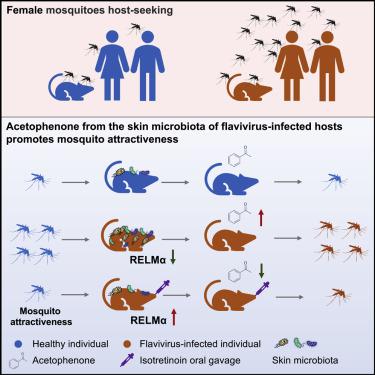Cell ( IF 45.5 ) Pub Date : 2022-06-30 , DOI: 10.1016/j.cell.2022.05.016 Hong Zhang 1 , Yibin Zhu 1 , Ziwen Liu 2 , Yongmei Peng 3 , Wenyu Peng 4 , Liangqin Tong 4 , Jinglin Wang 5 , Qiyong Liu 6 , Penghua Wang 7 , Gong Cheng 1

|
The host-seeking activity of hematophagous arthropods is essential for arboviral transmission. Here, we demonstrate that mosquito-transmitted flaviviruses can manipulate host skin microbiota to produce a scent that attracts mosquitoes. We observed that Aedes mosquitoes preferred to seek and feed on mice infected by dengue and Zika viruses. Acetophenone, a volatile compound that is predominantly produced by the skin microbiota, was enriched in the volatiles from the infected hosts to potently stimulate mosquito olfaction for attractiveness. Of note, acetophenone emission was higher in dengue patients than in healthy people. Mechanistically, flaviviruses infection suppressed the expression of RELMα, an essential antimicrobial protein on host skin, thereby leading to the expansion of acetophenone-producing commensal bacteria and, consequently, a high acetophenone level. Given that RELMα can be specifically induced by a vitamin A derivative, the dietary administration of isotretinoin to flavivirus-infected animals interrupted flavivirus life cycle by reducing mosquito host-seeking activity, thus providing a strategy of arboviral control.
中文翻译:

黄病毒感染宿主皮肤微生物群的挥发物可增强蚊子的吸引力
食血节肢动物的寻找宿主活动对于虫媒病毒传播至关重要。在这里,我们证明蚊子传播的黄病毒可以操纵宿主皮肤微生物群,产生吸引蚊子的气味。我们观察到,伊蚊更喜欢寻找并捕食感染登革热和寨卡病毒的小鼠。苯乙酮是一种主要由皮肤微生物群产生的挥发性化合物,在受感染宿主的挥发物中富含,可有效刺激蚊子的嗅觉以产生吸引力。值得注意的是,登革热患者的苯乙酮排放量高于健康人。从机制上讲,黄病毒感染抑制了 RELMα(宿主皮肤上一种重要的抗菌蛋白)的表达,从而导致产生苯乙酮的共生细菌扩张,从而导致苯乙酮水平升高。鉴于 RELMα 可以由维生素 A 衍生物特异性诱导,通过饮食向黄病毒感染的动物施用异维A酸可以通过减少蚊子寻找宿主的活动来中断黄病毒的生命周期,从而提供一种虫媒病毒控制策略。











































 京公网安备 11010802027423号
京公网安备 11010802027423号